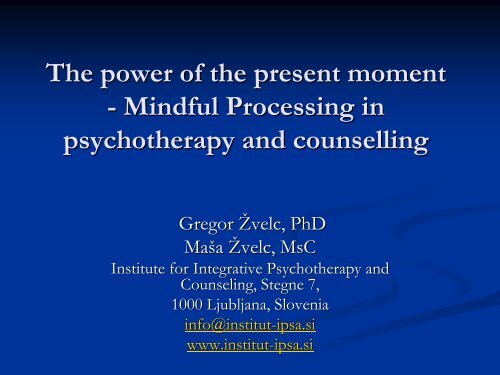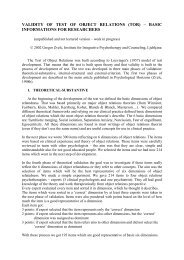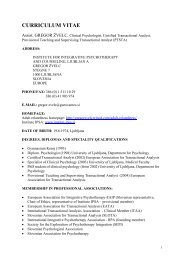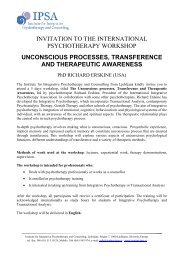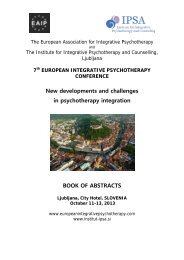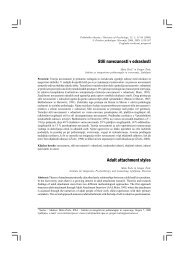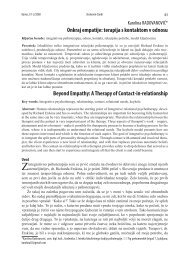Use of Mindful Processing - IPSA
Use of Mindful Processing - IPSA
Use of Mindful Processing - IPSA
Create successful ePaper yourself
Turn your PDF publications into a flip-book with our unique Google optimized e-Paper software.
The power <strong>of</strong> the present moment<br />
- <strong>Mindful</strong> <strong>Processing</strong> in<br />
psychotherapy and counselling<br />
Gregor Žvelc, PhD<br />
Maša Žvelc,<br />
MsC<br />
Institute for Integrative Psychotherapy and<br />
Counseling, , Stegne 7,<br />
1000 Ljubljana, Slovenia<br />
info@institut<br />
@institut-ipsa.siipsa.si<br />
www.institut-ipsa.si<br />
ipsa.si
‘It is remarkable how little we know about<br />
experience that is happening right now… This<br />
relative ignorance is especially strange in light <strong>of</strong><br />
the following:<br />
First we are subjectively alive and conscious<br />
only now. Now is when we directly live our lives.<br />
Everything else is once or twice removed. The<br />
only time <strong>of</strong> raw subjective reality, <strong>of</strong><br />
phenomenal experience, , is the present moment’<br />
(Daniel Stern, , p. 3, The Present Moment in<br />
Psychotherapy and Everyday Life)
What is mindfulness<br />
<strong>Mindful</strong>ness means paying attention<br />
in a particular way:<br />
on purpose<br />
in the present moment<br />
and nonjudgmentally.<br />
Jon Kabat-Zinn
Definition <strong>of</strong> <strong>Mindful</strong>ness<br />
<strong>Mindful</strong>ness is non-judgemental,<br />
accepting awareness <strong>of</strong> what is<br />
goingon in presentmoment<br />
(Černetič, 2005).
Construct <strong>of</strong> mindfulness<br />
• Direct experience in the present moment is<br />
fundamental part <strong>of</strong> Buddhist, , Christian, Hindu,<br />
Islamic, Jewish and Taoist teaching (Siegel,<br />
2007)<br />
• Construct <strong>of</strong> mindfulness as psychological<br />
construct independent <strong>of</strong> traditions – inherent<br />
capacity <strong>of</strong> human organism<br />
• Increasing number <strong>of</strong> research in last 10 years in<br />
clinical and health psychology
TWO MODES OF MIND<br />
(Segal, Williams & Teasdale, , 2002)<br />
• DOING mode is entered when we register discrepancies between<br />
the idea how things are and an idea <strong>of</strong> how we wished things to be. b<br />
The aim <strong>of</strong> this mode is to effectively solve problems. In the case <strong>of</strong><br />
mental difficulties, doing mode is aiming towards change <strong>of</strong> existing<br />
problems. This mode <strong>of</strong> functioning also involves continuous<br />
monitoring and evaluation <strong>of</strong> progress towards reducing the gap<br />
between the problematic state and the desired goal. This mode <strong>of</strong>ten<br />
produces a sense <strong>of</strong> dissatisfaction, because this mode is preoccupied<br />
with mismatches between present and desired state.<br />
• BEING mode is the opposite <strong>of</strong> the doing mode. The focus <strong>of</strong> the<br />
being mode is ‘accepting’ and ‘allowing’ what is, , without any<br />
immediate pressure to change it. Being mode is concerned with<br />
immediate experience <strong>of</strong> the present moment. . <strong>Mindful</strong>ness invites us<br />
in Being mode <strong>of</strong> mind.
<strong>Mindful</strong>ness Based Treatment<br />
Approaches<br />
• <strong>Mindful</strong>ness Based Stress Reduction (MBSR)<br />
• <strong>Mindful</strong>ness Based Cognitive Therapy (MBCT)<br />
<strong>Mindful</strong>ness is developed through intensive<br />
mindful meditation practice.
Benefits <strong>of</strong> mindfulness<br />
• <strong>Mindful</strong>ness training helps to reduce subjective states <strong>of</strong><br />
suffering, improve immune functioning, accelerate rates<br />
<strong>of</strong> healing, nurture interpersonal relationships and an<br />
overall sense <strong>of</strong> well being (Davidson<br />
et al, , 2003)<br />
• <strong>Mindful</strong>ness based cognitive therapy prevents relapse in<br />
cases <strong>of</strong> chronic depression (Segal, Williams, &<br />
Teasdale, , 2002)<br />
• <strong>Use</strong> <strong>of</strong> mindfulness training with different disorders:<br />
borderline personality disorder, , substance abuse<br />
problems, obsessive-compulsive<br />
disorder, anxiety<br />
disorders.
Development <strong>of</strong> <strong>Mindful</strong> <strong>Processing</strong><br />
technique<br />
• <strong>Mindful</strong>ness <strong>Processing</strong> invites the client to become aware <strong>of</strong><br />
moment to moment subjective experience with acceptance.<br />
• Relational mindfulness – the therapist is also in state <strong>of</strong> presence<br />
and invites the client to be mindful <strong>of</strong> present moment (two<br />
minds are stronger then one mind!)<br />
• Difference with other mindfulness approaches:<br />
- the aim is to be mindful in relationship and not to<br />
meditate alone<br />
- awareness and acceptance <strong>of</strong> present moment promotes<br />
processing <strong>of</strong> experience in psychotherapy
<strong>Use</strong> <strong>of</strong> <strong>Mindful</strong> <strong>Processing</strong><br />
• As a separate technique or integrated in different<br />
psychotherapy schools<br />
• <strong>Use</strong> in psychotherapy, counseling and/or<br />
coaching<br />
• Can be used for:<br />
• Experiential exploration and processing <strong>of</strong> current<br />
issues<br />
• <strong>Processing</strong> <strong>of</strong> past painful experiences<br />
• Developing positive resources for the future use
<strong>Mindful</strong> <strong>Processing</strong> Protocol<br />
© Žvelc, 2006<br />
STEP 1: DESCRIPTION OF MINDFUL PROCESSING TO THE<br />
CLIENT<br />
STEP 2: DESCRIPTION OF THE ORIGINAL SITUATION<br />
'What issue would you like to discover more about'<br />
STEP 3: FINDING BODY SENSATION CONNECTED TO THE<br />
WHOLE<br />
PROBLEM<br />
‘When you think about the whole problem, how do you feel in your body<br />
now’<br />
'Where do you feel it in your body now'<br />
STEP 4: FOCUSING ON BODY SENSATION RELATED TO THE<br />
WHOLE PROBLEM<br />
'Just close your eyes and focus on that body sensation. Just observe what is<br />
happening.'
<strong>Mindful</strong> <strong>Processing</strong> Protocol<br />
© Žvelc, 2006<br />
CYCLE OF PROCESSING<br />
STEP 5: DESCRIPTION OF INNER EXPERIENCE<br />
'Just open your eyes and tell me what has happened.' (empathically) ly) or<br />
'O.K. just slowly open your eyes and tell me what occurred. '<br />
STEP 6: INTRAPSYCHIC CONTACT AND MINDFULNESS<br />
'Just stay with that _____________ (sensation, thought, feeling or image) or<br />
'Just focus on that'<br />
'Just observe that' or 'Just be aware <strong>of</strong> _______ (sensation, thought, feeling<br />
or image)<br />
GO TO STEP FIVE<br />
STEP 7: END OF PROCESSING<br />
You can check with the client if it is O.K. to stop here, or he would like to do additional cycles.<br />
If you decide to stop, then ask:<br />
‘If you bring the original problem in your awareness, what comes‘
Fundamental assumptions <strong>of</strong><br />
<strong>Mindful</strong> <strong>Processing</strong><br />
1.) NATURAL HEALING OF ORGANISM<br />
- Rogers and Gendlin<br />
- Adaptive information processing (Shapiro)<br />
2.)<br />
FOCUSING ON THE BODILY SENSATIONS<br />
- Contribution <strong>of</strong> Eugene Gendlin – ‘felt<br />
sense’<br />
3.)<br />
ESTABLISHING INTERNAL AND EXTERNAL<br />
CONTACT<br />
- Internal contact and external contact as essential healing<br />
mechanism in Integrative psychotherapy<br />
4.) ATTENDING TO MOMENT BY MOMENT<br />
EXPERIENCING
Fundamental assumptions <strong>of</strong><br />
<strong>Mindful</strong> <strong>Processing</strong><br />
5.)<br />
INTEGRATING AND MAKING NEW CONNECTION<br />
BETWEEN EXPERIENCE<br />
- Referential process (Bucci(<br />
Bucci): links between susbysmbolic (implicit)<br />
elements and symbolic elements<br />
6.)<br />
FREE ASSOCIATION<br />
7.) THERAPIST’S S ATTUNEMENT AND PRESENCE –<br />
‘RELATIONAL<br />
MINDFULNESS’<br />
8.) CONTAINING THE EXPERIENCE BY THERAPIST AND<br />
CLIENT<br />
9.)<br />
PROMOTES INTEGRATION AND PROCESSING OF<br />
COGNITIVE, AFFECTIVE AND SOMATIC EXPERIENCE
Preliminary qualitative research <strong>of</strong><br />
MP (Vodnik & Žvelc, 2008)<br />
Problem:<br />
What are ‘clients’ experiences during <strong>Mindful</strong> processing<br />
What is difference between MP and other techniques<br />
What clients value in MP<br />
Participants: 14 students <strong>of</strong> psychotherapy (second<br />
and<br />
third year <strong>of</strong> integrative psychotherapy and<br />
transactional analysis)
Procedure: Participants had a session <strong>of</strong> <strong>Mindful</strong><br />
processing connected to problematic situation.<br />
Participants filled the questionnaire about their<br />
experience <strong>of</strong> <strong>Mindful</strong> <strong>Processing</strong> just after the<br />
session. ‘Therapists’ were students <strong>of</strong> second<br />
and third year <strong>of</strong> psychotherapy.<br />
Analyses: The researcher coded the participants<br />
description <strong>of</strong> their experiences and conducted<br />
the analysis.
<strong>Processing</strong> the<br />
experience<br />
Holistic (deep)<br />
experiencing<br />
Client’s<br />
Experience <strong>of</strong> <strong>Mindful</strong><br />
<strong>Processing</strong><br />
Awareness <strong>of</strong> the<br />
body<br />
Awareness <strong>of</strong><br />
emotions<br />
Insight
Conclusions – Typical client’s<br />
experience <strong>of</strong> MP<br />
1) In the beginning <strong>of</strong> MP clients were deeply<br />
experiencing body sensations and emotions connected<br />
with original situation.<br />
2) Emotional and bodily arousal was increasing and<br />
leading to relief and positive emotions. (transformation<br />
<strong>of</strong> emotions)<br />
3) These clients trusted the process without having the<br />
goal in mind. They could let go <strong>of</strong> the control and just<br />
accept what is happening moment from moment.<br />
4) Such stance toward experience lead to new insights and<br />
awareness regarding the original situation.
Conclusions<br />
• The second group <strong>of</strong> clients had difficulties in accepting<br />
and tolerating sensations and feelings. They tried to<br />
have strong control over the situation. These clients<br />
didn’t develop new insight or awareness about the<br />
problematic situation. However most <strong>of</strong> them<br />
experienced relaxation after MP.<br />
• In comparison with other psychotherapies participants<br />
describe <strong>Mindful</strong> processing as non-oriented<br />
oriented toward<br />
goal, bodily oriented, non-directive<br />
and client-centred<br />
centred.
Original situation<br />
Awareness <strong>of</strong> body<br />
sensations<br />
DEEP<br />
EXPERIENCING<br />
Awareness <strong>of</strong><br />
emotions<br />
<strong>Mindful</strong> <strong>Processing</strong><br />
Model (Žvelc,(<br />
2008)<br />
Accepting and tolerating<br />
‘difficult’ experiences.<br />
Verbalisation <strong>of</strong> experience.<br />
Extracting the meaning from<br />
emotional experience.<br />
TRANSFORMATION OF EMOTIONS<br />
Positive emotions and<br />
body sensations,<br />
new awareness – insight.
WE INVITE YOU TO<br />
DISCOVER THE POWER<br />
OF PRESENT MOMENT<br />
THROUGH MINDFUL<br />
PROCESSING<br />
www.institut-ipsa.si<br />
ipsa.si


